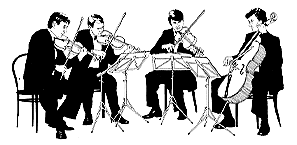|
|









|
|
|
|
|
BASSO Concert Notes for March 9
|
 In 1874, the great playwright Ibsen invited the composer Edvard Grieg (born in Bergen, June 15, 1843; died in Bergen, September 4, 1907) to write incidental music for his play, Peer Gynt. Because Grieg assumed that he only needed to write a few short pieces he quickly accepted the commission, however, he soon realized that he had a much larger task on his hands. He accepted the challenge nevertheless and took great pains with the score, which he finished in September 1875. The two suites use only eight numbers, four for each suite, out of a total of twenty-three. The Peer Gynt Suite [No. 1] Op. 23 uses numbers 13, 12, 16 and 7, which contain the famous "Morning Mood" and "In the Hall of the Mountain King." Solveigs Songs, number 11 from the Peer Gynt Suite [No. 2], is hauntingly beautiful and one of Grieg's proudest achievements. The music reveals a lyricism of the highest order as well as freshness and charm that are irresistible.
In 1874, the great playwright Ibsen invited the composer Edvard Grieg (born in Bergen, June 15, 1843; died in Bergen, September 4, 1907) to write incidental music for his play, Peer Gynt. Because Grieg assumed that he only needed to write a few short pieces he quickly accepted the commission, however, he soon realized that he had a much larger task on his hands. He accepted the challenge nevertheless and took great pains with the score, which he finished in September 1875. The two suites use only eight numbers, four for each suite, out of a total of twenty-three. The Peer Gynt Suite [No. 1] Op. 23 uses numbers 13, 12, 16 and 7, which contain the famous "Morning Mood" and "In the Hall of the Mountain King." Solveigs Songs, number 11 from the Peer Gynt Suite [No. 2], is hauntingly beautiful and one of Grieg's proudest achievements. The music reveals a lyricism of the highest order as well as freshness and charm that are irresistible.
Jean Sibelius (born December 8, 1865; died September 20, 1957) is rightly considered the greatest Finnish composer. His extraordinary symphonies alone have earned him a high place in the history of music. Like the Romantic composer Hector Berlioz, Sibelius was a composer whose inspiration was sparked by the sounds of an orchestra and this is certainly true of Luonnotar, which is a tone poem for soprano and orchestra and comes from the years 1909-10. It is a fascinating masterpiece that can be thought of as half song and half symphonic poem. Although it is very demanding on the soloist, who must sing wide melodic leaps, it is also very musical.
The third Scandinavian composer to be heard in this concert is Johan Svedsen. He was an extremely kind and helpful man who advised and encouraged many young composers, one of which was the great Danish composer Carl Nielsen. Svendsen and Grieg represent two mighty pillars in Norwegian Romantic music, with the work of each complimenting the other. Svendsen had an affinity for the orchestra and for large forms. Both of which are apparent in the Symphony No. 2 in B major Op. 15. It is considered by many to be his masterpiece. Soon after the writing of this symphony Svendsen moved to Copenhagen where, somewhat inexplicably, his productivity dried up. It is believed that he had written a third symphony, but one day in a fit of anger, his wife took the finished manuscript and threw it into the fire! Ibsen learned of this incident and duplicated it in a celebrated scene from Hedda Gabler.
Program for Tuesday,March 9
Conductor Ari Rasilainen,
Soprano Satu Vihauainen
E.H. Grieg: Peer Gynt Suite No. 1; "Solveigs Songs,"
Peer Gynt No. 2 for soprano and orchestra.
J.Sibelius: "Luonnotar" for soprano and orchestra, Three Songs.
J.S. Svedsen: Symphony No. 2.
Faculty of Music and Performing Arts Auditorium, 9 p.m.
For more information and reservations, call 266-4382.

|
|
|

|







